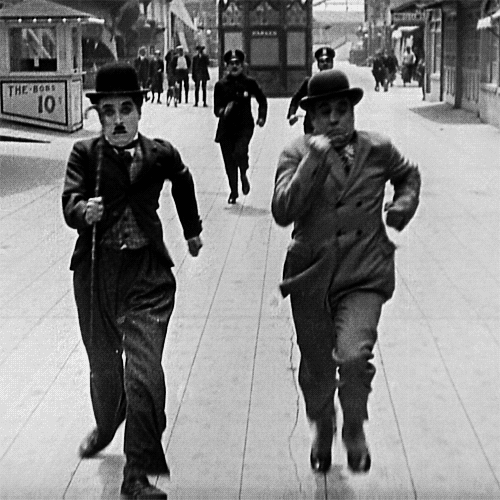In this unit I learned about.....
CIRCULAR MOTION
Linear speed: the distance traveled per unit of time
Tangential speed: something moving along a circular path
Rotational/angular speed: number of rotations or revolutions per unit of time

Who has a higher tangential speed? Darth Vader or the guy in the far left?
The guy on the far left actually has a higher tangential speed because he is on the outside of the carousel. Because he is on the outside, he is further away from the axis of rotation and will need to go faster in order to maintain the same rotational speed and travel the same distance in the same time interval.
Running on a track is the same scenario, the runners on the outside will need to go faster in order to maintain the rotational speed of those running on the inside
Gears?
Gears kind of contradict our previous ideas of rotational and tangential speed because gears actually have the same tangential speed, but differ in their rotational speed. This is because in order to cover the same distance, they have to go at different rates because they are different sizes and have different amounts of teeth. However, tangential speeds are the same because a point on the edge of each gear will cover the same distance in the same time interval.
So how do train wheels work?

Train wheels are designed very carefully based on our knowledge of tangential and rotational speed!

One of the key aspects to train wheels is the fact that they have unequal tangential velocities. The wide part of the wheel has a large tangential velocity while the small part has a slow tangential velocity. The fast part of the wheel causes the wheels to curve toward the track and self correct. (rotational velocity is the same)
Are monster trucks really that cool?
Are monster trucks really that cool?

Of course not, not only do they look ridiculous, larger tires actually make you go slower. This is because the rotational speed will be less because it takes longer for each tire to make a full circuit.
Rotational Inertia and Angular Momentum

Who is going faster?

The ballerina!
This is because she has less rotational inertia which means MORE rotational velocity!
How does this work?
Rotational Inertia:
like regular inertia, inertia is the property to resist changes in motion. (hello, newtons 1st law)
It is the property of an object to resist changes in spin
Lots of rotational inertia=harder to spin
Less rotational inertia=easier to spin
It also depends on mass! however, it primarily matters where that mass is located.
As you can see in the pictures above, when the dancer brings her arms in, she goes faster. This is because when mass is located closer to the axis of rotation, it will have less rotational inertia. However, when the girl below her held her arms out, she went slower. This is because her mass is mainly located far away from the axis of rotation, so it will have MORE rotational inertia.
Why do runners bend their legs?

When you bend your legs, you are bringing your mass closer to your axis of rotation, therefore making it easier to spin.
Conservation of Rotational/Angular Momentum
total momentum before=total momentum after
Angular momentum is based off of rotational inertia and velocity
angular momentum=rotational inertia x rotational velocity
R.I. x R.V. (before)= R.I. x R. V. (after)
 notice the rotational inertia and velocity before and after she brought her mass together and spun.
notice the rotational inertia and velocity before and after she brought her mass together and spun. R.I. x r.v. (before)= r.i. x R.V. (after)
before she spun she had more inertia and less velocity, but while spinning she had less inertia and more velocity. Because angular momentum before=angular momentum after, they must equal each other.
TORQUE AND CENTER OF GRAVITY
Torque= something that causes rotation
torque=force x lever arm
(btw lever arm is the distance from the axis of rotation)
Hmm....where should I put my doorstop?
as far to the edge as possible! why? because you are increasing the lever arm! through increasing the lever arm you are increasing the torque which will make the door stay put!
hmmm, which wrench should I use?
you probably think the first because it is much BIGGER than option 2. However, that is not the major reason! The first wrench would cause a larger torque because it has a LONGER lever arm!
CENTER OF MASS/GRAVITY
Center of mass: average position of all of an objects mass
Center of gravity: is when gravity acts on this spot
so why do I have to bend forward when I wear a backpack?

This is because adding a backpack is adding more mass. SO, your center of mass shifts. In order to stay balanced (center of gravity must always be above the base of support) you have to lean forward.
who is more likely to fall over?
The model! why? Because, as shown in the picture, Nadal has his legs spread far apart and his knees bent. By doing this, he is increasing his base of support therefore making it harder for his center of gravity to fall out of the perimeter of his base of support. Additionally, his knees are bent making his center of gravity lower, and also making it more difficult for his center of gravity to fall out of his base of support. The model is standing up straight and her legs are very close together, making it fairly easy for her to fall. (also she is wearing high heels, yikes.)
How do we balance?
 we become balanced when the counter clockwise torque=the clockwise torque. This means that the force x lever arm of one side equals the force x lever arm of another side. This does not necessarily mean they need to have the same force or lever arm. Together, they just need to equal each other.
we become balanced when the counter clockwise torque=the clockwise torque. This means that the force x lever arm of one side equals the force x lever arm of another side. This does not necessarily mean they need to have the same force or lever arm. Together, they just need to equal each other.
Balance means there is no net torque
notice how this tight rope walker keeps his arms out while walking in order to keep balance. why?
he does this because through having his arms out, he is able to obtain more rotational inertia. You can gain more torque when you have your arms out (more lever arm) therefore gain your balance back more easily.
why do we feel speed bumps more in in the front or back of a school bus rather than the middle?
Centripital/Centrifugal Force
Rewind to the inertia days...
central question: why, when we turn corners in cars, does it feel as if we are slamming into the side of the car?
INERTIA
you keep going straight forward, however, your car is effected by centripetal force therefore there is a force acting on it wanting to to come to the center, SO it does, and while it is doing so, it slams into you.
Centripetal force: the center seeking force, keeps you going into a curve
Centrifugal force: doesn't even exist...
Centripetal force is the force pushing on an object that has regular inertia, causing it to change it's direction. It accelerates an object causing it to change directions.
So why don't I just go straight to the middle because of centripetal force?
BECAUSE newton's 1st law causes you to go sideways because you still want to remain in a straight line, but centripetal force wants you to go to center, SO you go sideways!
Where else does this happen?

The moon has inertia and centripetal force therefore will constantly go in a circular motion around the earth!
don't get confused: even though we don't change speed, we change direction which changes velocity
What happens in washing machines?

Clothes, (or snoopy...) are trying to go straight (inertia) while the machine is going in a circle, causing the clothes to smack the sides therefore water is getting smacked out of them through the holes. Centripetal force acts on the clothes and they are forced in a circular path, but the water is not.
Real life Centripetal force scenarios....

roller coasters-gravity acts as centripetal force. They make the path smaller than the wider force of gravity path making you not only stay, but have a greater acceleration.
Race-cars and banked tracks. If the ground were flat, friction would be the only force. However, when the ground is being pushed up, centripetal force is left. There is centripetal force simply out of the race track be slanted, giving the car more centripetal force.
WHAT I FOUND MOST DIFFICULT ABOUT THIS UNIT
I think that I found centripetal force the most complex in this unit. I had a lot of trouble, particularly with the race car concept, which was accompanied with the roller coaster concept. However, I got extra help, and also looked at other people's physics blogs for references in various issues I have had this semester. I think that the light bulb clicked during class, when we were going over answers at our table. Wyatt explained something to me which made the concepts much easier to understand.
Problem Solving Skills
I think that this semester has been a huge turn around for me. Last semester, although I tried, I wasn't completely engaged in physics. However, this semester I have tried to be fully attentive during class, as well as complete my homework thoroughly instead of just trying to get it over with. I also started studying with friends for quizzes which helped me a lot, as my quiz grades have improved. With a greater effort, I am finding that physics is coming easier to me, therefore my problem solving skills are definitely improving.
*real life comparisons are in previous explanations*
Like I mentioned in previous blog posts, physics is really present in everything we do. As I learn more about it, I become much more aware of the world around me, and much more interested.







